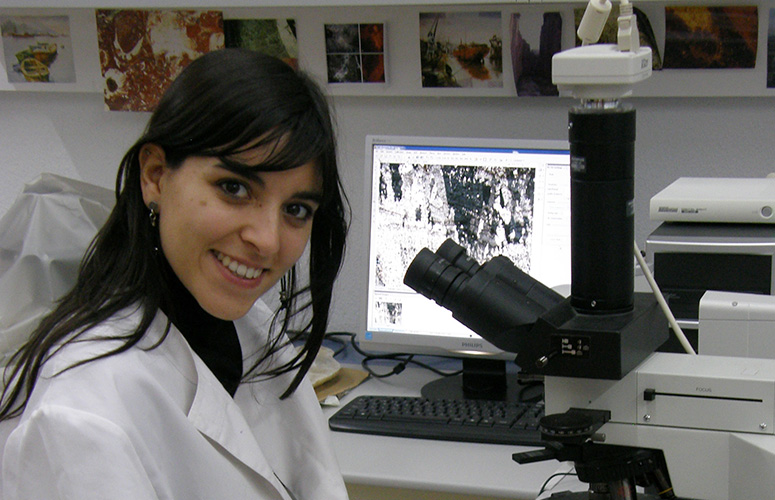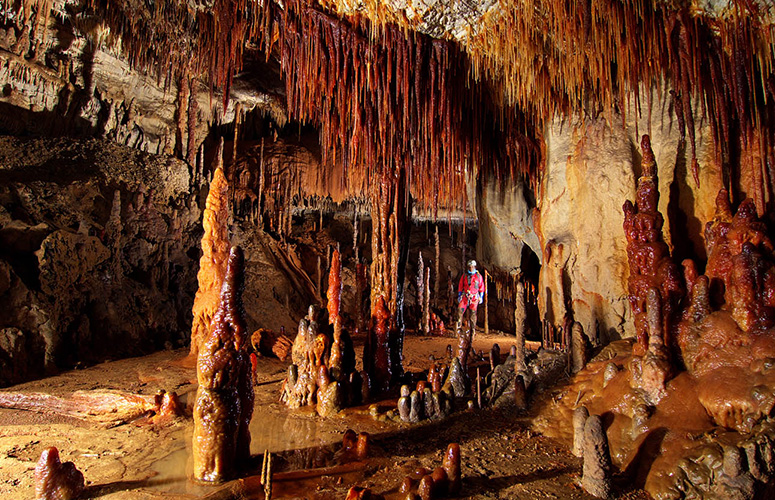A study by the UPV/EHU confirms the cause of the mysterious red colour of the stalagmites in the Goikoetxe Cave located in the Urdaibai Biosphere Reserve, and its potential use as an indicator of palaeoclimate changes on the Cantabrian seaboard between 7,000 and 5,000 years ago.
Discovering the cause of the red colouration in stalagmites and its possible connection with palaeoclimate changes
A study by the UPV/EHU discovers for the first time that the red colour of stalagmites can be used as a record to establish climate changes
- Research
First publication date: 27/04/2020

As a general rule, the colour red in geological and archaeological samples tends to be due to the presence of various iron oxides that dye minerals and rocks a very deep colour. However, “the studies conducted in this piece of work and published in the Quaternary International journal have shown that in the case of the stalagmites in the Goikoetxe Cave located in the Basque Country’s Urdaibai Biosphere Reserve, the red colouration is due to the presence of organic substances produced by the decomposition of vegetation cover in the soils located on top of the cave”, said Virginia Martínez-Pillado, researcher in the UPV/EHU’s Department of Mineralogy and Petrology and lead author of this work. “All along the Cantabrian seaboard there is a lot of precipitation and vegetation, and that is why a large vegetation cover forms on top of the cave; when this vegetation degrades, these organic substances, mainly humic and fulvic acids, are dragged into the cave by rainwater, and dye the speleothems red when the red from the calcite that forms them is incorporated,” explained Virginia Martínez-Pillado.
The authors of this work have combined various analysis techniques for these stalagmites of different colours, such as uranium-series radiometric dating, petrography, X-ray fluorescence, spectroscopy and ultraviolet light luminescence. “To conduct the analyses, two spectroscopic techniques known as Raman and FTIR were used; their purpose is to identify various types of molecules and compounds. These techniques were the ones that established the presence of organic compounds produced by the degradation of plant matter inside the stalagmites,” said the lead author of the work.
In addition “we used ultraviolet light to take photographs of the stalagmites themselves, and the response of the calcite in the presence of ultraviolet radiation was found to be cyclical. So, inside the red stalagmites, the red ones only,” stressed the researcher, “certain cycles have appeared in which organic substances have been incorporated to a lesser or greater degree; at the moments where there is increased organic incorporation there seems to have been a much denser vegetation. It is probably because precipitation was higher, although this is something that would still have to be explored in further depth,” said Martínez-Pillado. What is clear, however, is that “the vegetation cover and soil production is much more intense at certain moments than in others throughout the mid-Holocene, between 7,000 and 5,000 years ago, and is closely connected with the climate conditions outside the cave”.
These cycles detected and linked to the striking red colour have allowed the researchers to embark on new research designed to reconstruct climate evolution along the Cantabrian seaboard during this period. “Until now, it has not been known that this red colour could point to climate changes or could be used as a record to determine the climate changes themselves,” said Virginia Martínez-Pillado.
Additional information
This study was led by Virginia Martínez-Pillado of the UPV/EHU and the UCM-ISCIII Joint Centre with the collaboration of Iñaki Yusta and Arantza Aranburu, researchers in the UPV/EHU´s department of Mineralogy and Petrology. The National Human Evolution Research Centre (CENIEH) collaborated in the analyses. The University of Burgos (UBU) also participated in addition to the UPV/EHU, the UCM-ISCIII and the CENIEH.
Bibliographic reference
- The red coloration of Goikoetxe Cave´s speleothems (Busturia, Spain): An indicator of paleoclimatic changes
- Quaternary International (2020)
- DOI: 10.1016/j.quaint.2020.04.006







